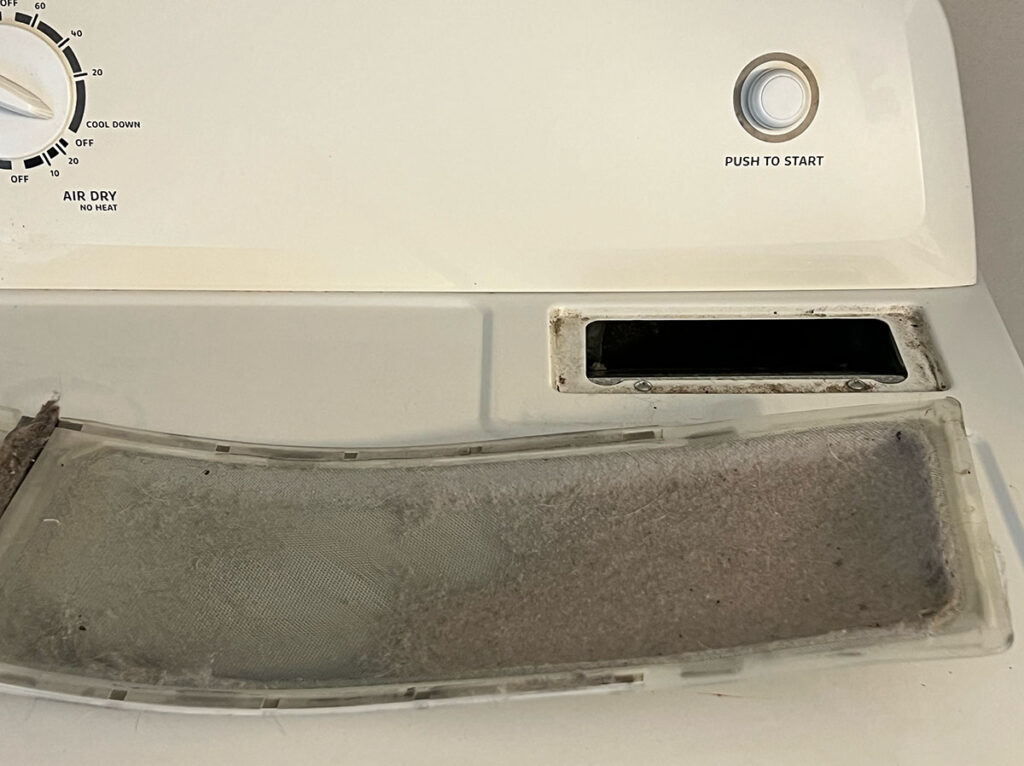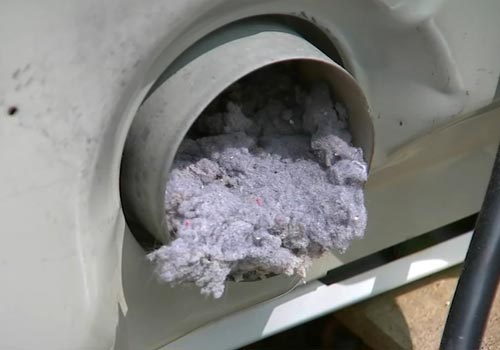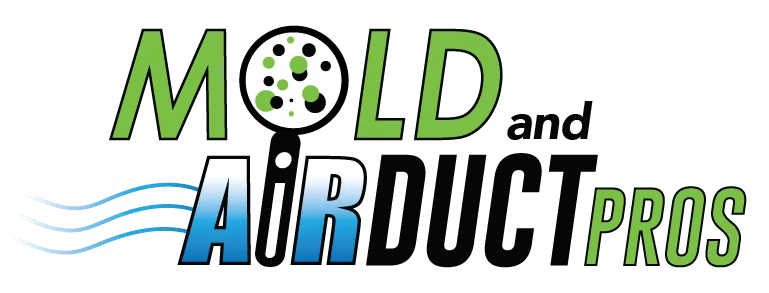Dryer maintenance might not always be at the top of your mind, but it’s something we think about a lot. Properly caring for your dryer can mean energy savings, a longer lifespan for your dryer, and a safer home environment. As air duct professionals, one of the questions people ask us most is how often to clean a dryer vent. But the answer isn’t as simple as it may seem.
Table of Contents
Dryer Exhaust Vent vs. Lint Trap
Before we begin, let’s distinguish between a lint trap and a dryer exhaust vent. A lint trap is the wire netting that slides in and out of your dryer and collects lint while you dry your clothes. You likely clean it out before or after every cycle.
On the other hand, the dryer vent is the exhaust and duct system that carries heat from your dryer outside of your home. It requires less frequent cleaning than a lint trap but should never be ignored.


Three Reasons to Clean Your Dryer Vent
Keep Your Home Safe
While having a dryer in your home is a huge convenience, it can also mean danger—especially if you don’t properly maintain it.
According to the United States Federal Emergency Management Agency, over 2,000 residential clothes dryer fires are reported every year. On average, dryer fires cause five deaths, 100 injuries, and $35 million in property loss annually. And the number one leading cause of residential dryer fires? Failure to clean dryer vents.
Costs and Energy Savings
Not only does infrequent cleaning of your dryer vent pose a threat to your safety, but it can also affect your wallet. Dryer vents that haven’t been cleaned will clog with lint and dust, meaning it takes longer to dry your clothes. Though you may not think much of it, ignoring this issue may lead to rising energy costs.
Dryer Warranty
Several appliances come with standard warranties that cover repairs within a specific time frame. However, consumers can unintentionally void their warranties if they fail to care for their appliances properly. For example, some manufacturers require yearly dryer vent cleaning for a dryer to remain under warranty.
How Often to Clean Your Dryer Vent
We recommend cleaning your dryer vent at least once every year. This ensures regular maintenance of your dryer’s exhaust system and reduces the likelihood of a dryer fire.
Of course, not every dryer is built the same, and not every household uses its dryer in the same way. For example, a family of six doing a load or two of laundry every day will need to clean its dryer vent more frequently than a single-person household.
If you’re unsure whether to clean your dryer vent more frequently, look for these signs.
- A burning smell. If you notice a burning smell every time you use a dryer, check out your the vent to make sure it’s clear of any lint or debris.
- Clothes take longer to dry. One of the first signs that your dryer vent needs cleaning is if your clothes take longer to dry after each use.
- It hasn’t been cleaned recently. If it’s been almost or more than one year since you last cleaned your dryer vent, that’s a tell-tale sign that it’s time to clean it out.
Can I Clean My Dryer Vent Myself?
While we always recommend hiring professionals to clean a dryer vent and ensure maximum safety for your family and the care of your dryer unit, we understand that not everyone may want or have that option. Follow these steps to clean your dryer vent by yourself.
(Disclaimer: the information in the following steps is strictly informational. If you decide to attempt the following yourself without a professional, you do so at your own risk and you will be liable for any damages or harm that may incur as a result. If your dryer is still under a warranty, you will be responsible for the warranty implications of performing service maintenance without the presence of a professional. We recommend you consult your dryer manufacturer if further warranty information is required. If you are renting or a part of an HOA, you should contact your landlord/office before performing service maintenance without a professional present.)
What You Will Need
- Thick Protective Gloves – The metal dryer exhaust can have a sharp metal edge; safety first.
- Protective Long Sleeves – Before reaching into a vent, ensure your arms are adequately protected from sharp metal edges.
- Flat-head screw driver and/or pliers – depending on how the exhaust vent is secured to your unit, you may need either a flat-head screw driver or standard pliers to remove the hose clamp.
- Shop vac or vacuum cleaner – Shop vacs are preferable here as there may be large pieces of lint that may clog a standard household vacuum cleaner. However, you may use a standard vacuum if that is all you have access to.
- Flexible Brush / brush vacuum extension – to effectively remove all possible lint from the exhaust, it is important to have a flexible brush fit can run through the entire length of your dryer’s exhaust vent. There are brushes sold specifically for cleaning dryer vents. (For brushes built specifically for cleaning dryer vents, it is critical to follow the instructions provided by the brush manufacturer.)
- Broom and dustpan – There may be large pieces of lint that come out of the exhaust hose that are too large for your vacuum (or even too large for your shop vac). If that is the case, it is nice to have a broom handy.
Instructions
- Disconnect your dryer – Before you begin, make sure to turn off the electrical breaker to your dryer. This is recommended over simply unplugging your dryer because many dryers run on 220v and this can be dangerous to unplug manually on a live 220v circuit. If you use a gas dryer, shut off the gas valve by the dryer to ensure no gas leaks while moving the unit around. If the electrical line is preventing the dryer vent from being accessible, you may also unplug that now.
- Remove and clean the dryer duct. Next, disconnect the duct from where it enters the wall and the back of your dryer. Clear out the duct by hand and remove any lint or dust from openings in the dryer or wall.
- Check the vent. Find where your exhaust vent exits your house and ensure the area is clean and free from obstructions.
- Clean out the vent. Grab a flexible brush with an extendable handle to clean your vent. Carefully work the brush into the vent while clearing any dust or lint. You should clean the entire length of the vent as best you can. If you have a vacuum with a hose attachment, use it to clean out the vent after you’ve passed through with the brush.
- Remove any extra dust or lint. Take this time to clean your dryer and remove any additional dust or lint from surrounding areas. You should also clean out the lint trap each use.
- Piece the exhaust hose back together – This is a critical step. If any of the connections are not properly re-installed, you risk venting the warm, damp exhaust air inside your home. Excess moisture in your home can lead to potential mold exposure (how to clean black mold in your home). Fit all the connections back together and ensure the host clamps are securely fastened on each connection.
- Reconnect the power source and turn on the gas (if applicable) – remember to plug the unit back in and if it is a gas unit, be sure to turn the gas valve back on (the valve will be perpendicular to the gas pipe if the valve is off, and it will appear parallel to the pipe if the gas is turned on).
- Test the dryer’s functionality and connections – first, test the dryer without heat. This will safely ensure that you properly secured the fittings and hose clamps. Visually inspect for any areas where the hose may have become detached during this test. Feel for any blowing air around the connections and re-secure the hose clamps as needed; there should be little to no detectable air escaping the connections. The presence of escaping air could mean that there is still an obstruction in the exhaust or the connection is secured properly. Next, test with heat. Wait a few minutes to give the dryer time to heat up. If no heat is detected and it is a gas unit, double check the gas valve to ensure it is indeed turned on. After heat is detected and the all the exhaust hoses are still connected with no air leaks, your dryer vent cleaning is complete.
Remember, even though it can be very beneficial to properly clean your own dryer vent periodically, it is still important to have a professional clean and inspect this at least once a year because there may be buildups of lint that are not detectable or reachable without professional vent cleaning equipment.
Hiring a Pro
If you would like to have peace of mind knowing your dyer vent was cleaned by a professional and you are in the Cleveland area, feel free to reach out with questions.
